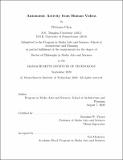Autonomic activity from human videos
Author(s)
Chen, Weixuan,Ph. D.Massachusetts Institute of Technology.
Download1227783016-MIT.pdf (3.959Mb)
Other Contributors
Program in Media Arts and Sciences (Massachusetts Institute of Technology)
Advisor
Rosalind W. Picard.
Terms of use
Metadata
Show full item recordAbstract
The autonomic nervous system (ANS) is a part of the nervous system that is responsible for regulation and integration of internal organs' functioning. Traditionally, for the assessment of the ANS function, autonomic activity is measured in various tests by medical devices with contact sensors. Most of these tests require wearing cumbersome equipment on the human body, so they are commonly conducted in clinics and only sporadic data can be collected. A potential solution to more convenient analysis of autonomic activity is via camera-based human sensing. Recent research has shown that it can be combined with computer vision algorithms to realize visualization of ANS activity in human videos and non-contact estimation of ANS parameters such as heart rate, respiration rate, and heart rate variability (HRV). However, there are still many hurdles that prevent the solution from reaching the accuracy and covering the scope of clinical tests: 1) The robustness of the existing methods are still unsatisfactory in ambulatory situations, especially when illumination changes and body motions are significant. 2) Previous visualization algorithms distort non-sinusoidal components of autonomic activity in motion magnification. 3) Potential ethics and privacy issues might impede the deployment of the new techniques. To address these problems, this dissertation proposes an end-to-end convolutional attention network using both gradient descent and gradient ascent to enable robust measurement and visualization under major motions, proposes a near-infrared-based carotid pulse tracker that can work under too dynamic or absent illumination, proposes a motion magnification algorithm that can magnify non-sinusoidal autonomic activity faithfully, discusses potential privacy issues in video-based autonomic activity monitoring, and as a solution proposes a framework for eliminating autonomic activity from facial videos without affecting their visual appearance. Through combining these proposed approaches, the final goal of the dissertation is to realize unobtrusive analysis of autonomic activity from human video that can work in the field.
Description
Thesis: Ph. D., Massachusetts Institute of Technology, School of Architecture and Planning, Program in Media Arts and Sciences, September, 2020 Cataloged from student-submitted PDF of thesis. Includes bibliographical references (pages 171-179).
Date issued
2020Department
Program in Media Arts and Sciences (Massachusetts Institute of Technology)Publisher
Massachusetts Institute of Technology
Keywords
Program in Media Arts and Sciences